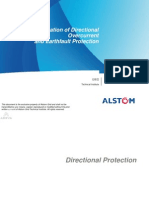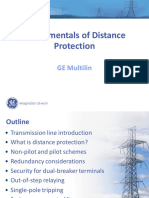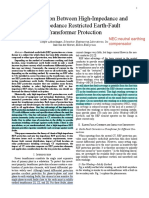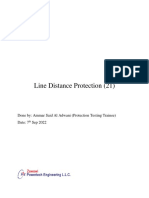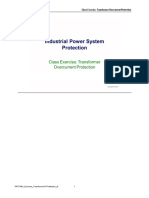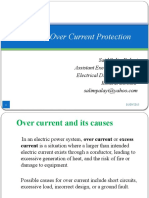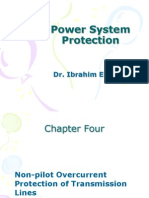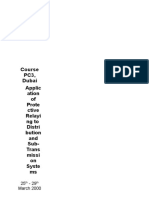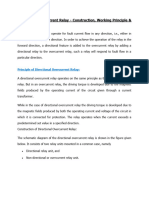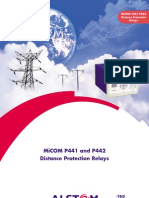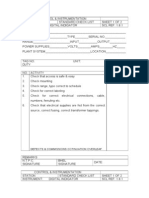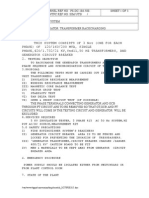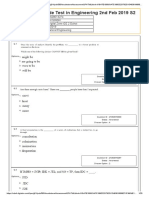Application of Directional Overcurrent
and Earthfault Protection
Application of Directional Overcurrent and Earthfault Protection - January 2004
�Directional Protection
Application of Directional Overcurrent and Earthfault Protection - January 2004
�Need for Directional Control
Generally required if current can flow in both directions
through a relay location
e.g. Parallel feeder circuits
Ring Main Circuits
0.9
0.1
0.5
0.5
0.1
0.9
Relays operate for current flow in direction indicated.
(Typical operating times shown).
Application of Directional Overcurrent and Earthfault Protection - January 2004
�Ring Main Circuit
With ring closed :
Both load and fault current may flow in either
direction along feeder circuits.
Thus, directional relays are required.
Note: Directional relays look into the feeder.
Need to establish principle for relay.
51
67
67
67
Load
51
67
Load
67
Load
Application of Directional Overcurrent and Earthfault Protection - January 2004
67
�Ring Main Circuit
Procedure :
1.
Open ring at A
Grade : A' - E' - D' - C' - B'
2.
Open ring at A'
Grade : A - B - C - D - E
Typical operating times shown.
Note : Relays B, C, D, E may be non-directional.
A
1.7
A'
B'
C'
0.1
1.3
0.5
0.9
E'
0.1
1.3
1.7
Application of Directional Overcurrent and Earthfault Protection - January 2004
0.9
D'
0.5
�Parallel Feeders
Non-Directional Relays :-
Conventional Grading :Grade A with C
and Grade B with D
51 C
51 B
51 D
5
1
Load
Relays A and B have the same setting.
A&
B
C&D
Application of Directional Overcurrent and Earthfault Protection - January 2004
Fault
level
at F
�Parallel Feeders
Consider fault on one feeder :I1 + I2
I1
51 A
I2
51 B
51
51
LOAD
Relays C and D see the same fault current (I2).
As C and D have similar settings both feeders
will be tipped.
Application of Directional Overcurrent and Earthfault Protection - January 2004
�Parallel Feeders
Solution:- Directional Control at C and D
I1 + I2
I1
51 A
I2
51 B
67
LOAD
67
Relay D does not operate due to current flow in
the reverse direction.
Application of Directional Overcurrent and Earthfault Protection - January 2004
�Parallel Feeders
Setting philosophy for directional relays
E
51 A
Load
67
51
51 B
67
Load current always flows in non-operate direction.
Any current flow in operate direction is indicative of a
fault condition.
Thus Relays C and D may be set :- Sensitive (typically 50% load)
- Fast operating time (i.e. TMS=0.1)
Application of Directional Overcurrent and Earthfault Protection - January 2004
�Parallel Feeders - Application Note
Grade B with C at If1
Grade B with D at If2
(in practice)
Grade A with B at If - but check that sufficient
margin exists for bus fault at Q when relay A sees
total fault current If2, but relay B sees only If2/2.
If2
P
B
Loa
d
If1:One Feeder
If2:Two
Feeders
A
M = Margin
If2/2
If2
If2/2 If1If2
Application of Directional Overcurrent and Earthfault Protection - January 2004
Load
If
�Establishing Direction
Application of Directional Overcurrent and Earthfault Protection - January 2004
�Establishing Direction:- Polarising Quantity
The DIRECTION of Alternating Current may only be
determined with respect to a COMMON
REFERENCE.
In relaying terms, the REFERENCE is called the
POLARISING QUANTITY.
The most convenient reference quantity is
POLARISING VOLTAGE taken from the Power
System Voltages.
Application of Directional Overcurrent and Earthfault Protection - January 2004
�Directional Decision by Phase Comparison (1)
S1 = Reference Direction = Polarising Signal = V POL
S2 = Current Signal = I
OPERATION when S2 is within 90 of S1 :S1
S2
S2
S2
S2
Application of Directional Overcurrent and Earthfault Protection - January 2004
S2
S2
S2
�Directional Decision by Phase Comparison (2)
RESTRAINT when S2 lags S1 by between 90 and 270 :S1
S2
S2
S2
S2
S2
S2
Application of Directional Overcurrent and Earthfault Protection - January 2004
S2
�Polarising Voltage for A Phase Overcurrent Relay
OPERATE SIGNAL
POLARISING SIGNAL :Selectable from
VA
VB
VC
VA-B
VB-C
VC-A
Application of Directional Overcurrent and Earthfault Protection - January 2004
IA
Which voltage to use ?
�Directional Relay
Applied Voltage
Applied Current
:
:
VA
IA
VA
IA
Operate
IAF
VAF
Restrain
Question :
- is this connection suitable for a typical power system ?
Application of Directional Overcurrent and Earthfault Protection - January 2004
�Polarising Voltage
Applied Voltage : VBC
Applied Current : IA
VA
IA
IAF
MAXIMUM SENSITIVITY LINE
VBC
IVBC
VBC
Polarising voltage remains healthy
Fault current in centre of characteristic
ZERO SENSITIVITY
LINE
Application of Directional Overcurrent and Earthfault Protection - January 2004
�Relay Connection Angle
The angle between the current applied to the relay and the
voltage applied to the relay at system unity power factor
e.g. 90 (Quadrature) Connection :
IA and VBC
IA
VA
90
VBC
VB
C
The 90 Vconnection
is now used for all overcurrent
relays.
30 and 60 connections were also used in the past, but no
longer, as the 90 connection gives better performance.
Application of Directional Overcurrent and Earthfault Protection - January 2004
�Relay Characteristic Angle (R.C.A.)
for Electronic Relays
The angle by which the current applied to the relay must
be displaced from the voltage applied to the relay to
produce maximum operational sensitivity
e.g. 45
OPERATE
RESTRAIN
IA FOR MAXIMUM OPERATE
SENSITIVITY
VA
45
RCA
Application of Directional Overcurrent and Earthfault Protection - January 2004
VBC
�90 Connection - 45 R.C.A.
MAX SENSITIVITY
LINE
OPERATE
IA
VA
RESTRAIN
45
IA FOR MAX
SENSITIVITY
VA
90
45
VBC
VC
135
VB
RELAY CURRENT VOLTAGE
A
IA
VBC
IB
VCA
IC
VAB
Application of Directional Overcurrent and Earthfault Protection - January 2004
VBC
�90 Connection - 30 R.C.A.
OPERATE
MAX
SENSITIVITY
LINE
RESTRAIN
IA
VA
30
90
VBC
VC
IA FOR MAX
SENSITIVITY
VA
30
150
VB
RELAY CURRENT VOLTAGE
A
IA
VBC
IB
VCA
IC
VAB
Application of Directional Overcurrent and Earthfault Protection - January 2004
VBC
�Selection of R.C.A. (1)
Overcurrent Relays
90 connection 30 RCA (lead)
Plain feeder, zero sequence source behind relay
Application of Directional Overcurrent and Earthfault Protection - January 2004
�Selection of R.C.A. (2)
90 connection 45 RCA (lead)
Plain or Transformer Feeder :- Zero Sequence Source in Front of
Relay
Transformer Feeder :- Delta/Star Transformer in Front of Relay
Application of Directional Overcurrent and Earthfault Protection - January 2004
�Directional Earthfault Protection
Application of Directional Overcurrent and Earthfault Protection - January 2004
�Directional Earth Fault
Requirements are similar to directional overcurrent
i.e. need operating signal
and polarising signal
Operating Signal
obtained from residual connection of line CT's
i.e. Iop = 3Io
Polarising Signal
The use of either phase-neutral or phase-phase voltage as
the reference becomes inappropriate for the comparison
with residual current.
Most appropriate polarising signal is the residual voltage.
Application of Directional Overcurrent and Earthfault Protection - January 2004
�Residual Voltage
May be obtained from broken delta V.T. secondary.
VRES = VA-G + VB-G + VC-G = 3V0
Notes :
1.
VT primary must be earthed.
2.
VT must be of the '5 limb' construction (or 3 x single phase units)
VA-G
VB-G
VC-G
VRES
Application of Directional Overcurrent and Earthfault Protection - January 2004
A
B
C
�Directional Earth Fault Relays
Relay Characteristic Angle
0 - Resistance earthed systems
45 (I lags V) - Distribution systems (solidly earthed)
60 (I lags V) - Transmission systems (solidly earthed)
Application of Directional Overcurrent and Earthfault Protection - January 2004
�Residual Voltage
Solidly Earthed System
ZS
ZL
A-G
VA
VA
VB VC
VC
VA
VB
VC
VB VC
VRES
VA
VC
VB
VB
VRES
VB
VC
Residual Voltage at R (relaying point) is dependant upon Z S / ZL ratio.
ZS0
VRES
x 3E
2ZS1 ZS0 2ZL1 ZL0
Application of Directional Overcurrent and Earthfault Protection - January 2004
�Residual Voltage
Resistance Earthed System
S
ZS
ZL
ZE
A-G
G
VA-G
G.F
VC-G
VB-G VC-G
VRES
VA-G
VC-G
VRES
S
R G.F
S V
A-G
R G.F
VB-G
VRES
VA-G
VC-G
VB-G VC-G
VB-G
VB-G
VRES
VB-G
VC-G
ZS0 3ZE
x 3E
2ZS1 ZS0 2ZL1 ZL0 3ZE
Application of Directional Overcurrent and Earthfault Protection - January 2004
�Directional Earth Fault Relays
Relay Characteristic Angle
0 - Resistance earthed systems
45 (I lags V) - Distribution systems (solidly earthed)
60 (I lags V) - Tranmission systems (solidly earthed)
Zero sequence network :-
V0 = ( - ) I0 (ZS0 + 3R)
ZS0
3R
I0
V0
Application of Directional Overcurrent and Earthfault Protection - January 2004
ZL0
�Directional Control
Static Relay (METI + MCGG)
M.T.A. Selectable
Characteristic Selectable
51
67
Overcurrent Unit
(Static)
Application of Directional Overcurrent and Earthfault Protection - January 2004
Directional Unit
(Static)
�Numerical Relay Directional Characteristic
Characteristic angle c
Zone of
c = -180 --- 0 --- + 180 forward start
forward operation
in 1 steps
+Is
c - 90
Polarising
thresholds
Vp > 0.6V
Vop > 0.6 to 80V
in 0.2V
steps
for
example
Application of Directional Overcurrent and Earthfault Protection - January 2004
Reverse start
c + 90
-Is

